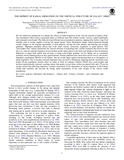Mostrar el registro sencillo del ítem
THE IMPRINT of RADIAL MIGRATION on the VERTICAL STRUCTURE of GALAXY DISKS
| dc.creator | Vera-Ciro C. | spa |
| dc.creator | D'Onghia E. | spa |
| dc.creator | Navarro J.F. | spa |
| dc.date.accessioned | 2017-05-12T16:05:58Z | |
| dc.date.available | 2017-05-12T16:05:58Z | |
| dc.date.created | 2016 | |
| dc.identifier.issn | 0004637X | |
| dc.identifier.uri | http://hdl.handle.net/11407/3155 | |
| dc.description.abstract | We use numerical simulations to examine the effects of radial migration on the vertical structure of galaxy disks. The simulations follow three exponential disks of different mass but similar circular velocity, radial scalelength, and (constant) scale height. The disks develop different non-axisymmetric patterns, ranging from feeble, long-lived multiple arms to strong, rapidly evolving few-armed spirals. These fluctuations induce radial migration through secular changes in the angular momentum of disk particles, mixing the disk radially and blurring pre-existing gradients. Migration primarily affects stars with small vertical excursions, regardless of spiral pattern. This "provenance bias" largely determines the vertical structure of migrating stars: inward migrators thin down as they move in, whereas outward migrators do not thicken up but rather preserve the disk scale height at their destination. Migrators of equal birth radius thus develop a strong scale-height gradient, not by flaring out as commonly assumed, but by thinning down as they spread inward. Similar gradients have been observed for low-[α/Fe] mono-abundance populations (MAPs) in the Galaxy, but our results argue against interpreting them as a consequence of radial migration. This is because outward migration does not lead to thickening, implying that the maximum scale height of any population should reflect its value at birth. In contrast, Galactic MAPs have scale heights that increase monotonically outward, reaching values that greatly exceed those at their presumed birth radii. Given the strong vertical bias affecting migration, a proper assessment of the importance of radial migration in the Galaxy should take carefully into account the strong radial dependence of the scale heights of the various stellar populations. © 2016. The American Astronomical Society. All rights reserved. | eng |
| dc.language.iso | eng | |
| dc.publisher | Institute of Physics Publishing | spa |
| dc.relation.isversionof | http://iopscience.iop.org/article/10.3847/1538-4357/833/1/42/meta;jsessionid=21FEC6A946A7E41099C7371A38264FD2.c1.iopscience.cld.iop.org | spa |
| dc.source | Scopus | spa |
| dc.subject | galaxies: kinematics and dynamics | spa |
| dc.subject | Galaxy: disk | spa |
| dc.subject | Galaxy: evolution | spa |
| dc.subject | stars: kinematics and dynamics | spa |
| dc.title | THE IMPRINT of RADIAL MIGRATION on the VERTICAL STRUCTURE of GALAXY DISKS | spa |
| dc.type | Article | eng |
| dc.rights.accessrights | info:eu-repo/semantics/restrictedAccess | |
| dc.rights.accessrights | info:eu-repo/semantics/restrictedAccess | |
| dc.contributor.affiliation | Vera-Ciro, C., Departamento de Ciencias Básicas, Universidad de Medellín, Cra 87 N 30-65, Medellín, Colombia, Department of Astronomy, University of Wisconsin, 475 N. Charter Street, Madison, WI, United States | spa |
| dc.contributor.affiliation | D'Onghia, E., Department of Astronomy, University of Wisconsin, 475 N. Charter Street, Madison, WI, United States | spa |
| dc.contributor.affiliation | Navarro, J.F., Department of Physics and Astronomy, University of Victoria, Victoria, BC, Canada | spa |
| dc.identifier.doi | 10.3847/1538-4357/833/1/42 | |
| dc.relation.ispartofes | Astrophysical Journal | spa |
| dc.type.driver | info:eu-repo/semantics/article |
Ficheros en el ítem
Este ítem aparece en la(s) siguiente(s) colección(ones)
-
Indexados Scopus [1632]

